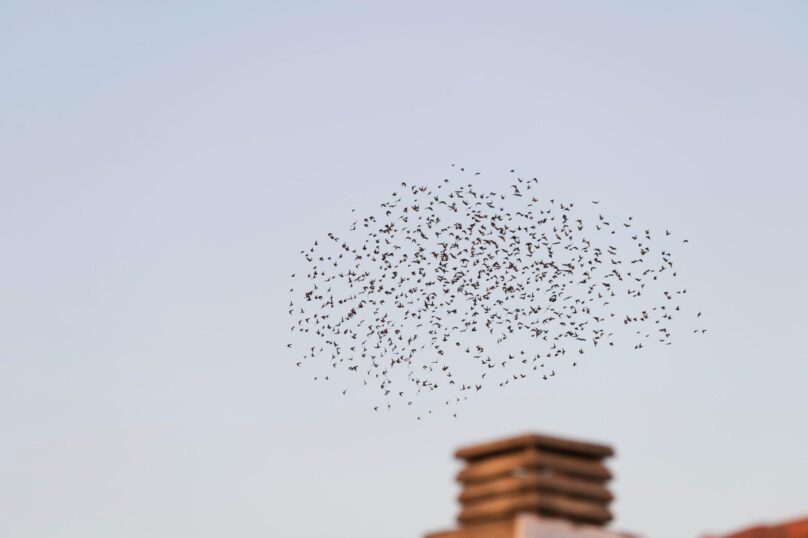
Birds that nest or gather on buildings can cause long-term damage by clogging drainage systems, corroding surfaces with droppings, and weakening structural materials. Their presence also attracts pests and leads to sanitation issues, especially in high-traffic zones like rooftops, signage, and HVAC units. If left unchecked, bird activity can result in costly repairs and safety hazards that disrupt business operations. Using bird deterrents helps minimize these risks early, preventing property damage before it becomes widespread. These proactive solutions are especially valuable for commercial and industrial properties, where maintaining appearance, functionality, and operational efficiency is crucial.
How Bird Deterrent Service Works
A bird deterrent service uses proven techniques to discourage birds from settling on structures without causing harm. These services involve a thorough inspection, choosing appropriate deterrent tools, and implementing a tailored strategy to protect affected areas. Technicians focus on keeping birds away while preserving the property’s appearance and function. Each step ensures long-term prevention and reduces the need for repeated cleanups or repairs:
Property Assessment and Site Inspection
Trained specialists inspect the property to identify high-traffic bird zones and signs of nesting or roosting. They examine rooftops, signage, ledges, vents, and other problem areas. The goal is to pinpoint where birds are entering or settling and determine the level of infestation. This assessment helps shape a strategy that targets specific behaviors and areas.
Selection of Bird Deterrent Tools
After the inspection, technicians select deterrents based on the property’s layout, the bird species, and the risk level. Options may include spikes, netting, repellent gels, sound devices, or visual distractions. Each tool is chosen for its ability to prevent landing, nesting, or perching in targeted zones. The service avoids one-size-fits-all methods and instead uses a layered solution.
Customized Installation Process
The team installs deterrents to block access and disrupt bird behavior in critical areas. Each product is carefully installed to prevent damage to structures or disruption of daily operations. They ensure everything is securely placed and weather-resistant for lasting performance. Once installed, these tools work immediately to deter birds from the area.
Ongoing Monitoring and Adjustments
After installation, specialists may return to monitor activity and adjust placements as needed if the birds adapt. They check for signs of return, reposition tools, or switch tactics if required. Continuous evaluation helps maintain effectiveness across seasons and different nesting cycles. This ongoing support keeps the property consistently protected.
Cleaning and Sanitation Measures
Before installing deterrents, accumulated droppings and nesting debris are removed. This method prevents contamination, restores appearance, and discourages birds from returning. Cleaning also helps ensure new deterrents are more effective by eliminating prior scents or markings. A clean slate makes it harder for birds to reclaim territory.
Areas Protected by a Bird Deterrent System
A bird deterrent system targets high-risk areas where birds often gather, nest, or leave droppings. These spots are common on commercial and industrial properties, and consistent exposure leads to property wear, safety hazards, and sanitation problems. By protecting these zones, the system helps maintain functionality, appearance, and long-term value. These areas benefit from deterrents that block access, reduce buildup, and prevent costly repairs:
Rooftops and HVAC Systems
Birds frequently land on flat rooftops, accumulating droppings that enter rooftop machinery. HVAC systems are particularly susceptible to clogs and corrosion caused by nesting materials or debris. Moisture trapped around these units can lead to mold, rust, and cooling inefficiencies. Installing barriers and repellents protects both the roof structure and mechanical equipment.
Building Facades and Ledges
Ledges and narrow building edges are ideal for birds to perch or nest. Droppings here stain exterior finishes and accelerate the breakdown of stone, paint, or metal. Over time, these messes become harder to clean and reduce curb appeal. Deterrents block access to these surfaces and keep birds away from visual focal points.
Parking Lots and Walkways
Open areas attract birds searching for food or shelter, especially near trash bins or food vendors. Droppings on sidewalks or vehicles create a mess, slip hazards, and cleaning expenses. Customers or staff may also avoid spaces that appear dirty or unsafe. Preventing birds from gathering nearby helps maintain cleaner, safer outdoor areas.
Warehouses and Storage Facilities
Large openings in warehouses and storage units make it easy for birds to fly in and establish a nest. Once inside, they can contaminate products, block ventilation, or trigger fire hazards through nest buildup. These spaces also suffer from odor and noise issues associated with bird infestations. Installing netting or other deterrents keeps interiors clean and compliant.
Signage and Decorative Elements
Due to their height and ledge-like design, birds often perch on signs, light fixtures, and exterior displays. Droppings and nesting materials damage finishes, block visibility, and shorten the life of expensive custom pieces. These messes also impact branding and visitor perception. Protecting signage with visual or physical deterrents ensures it stays visible and intact.
Why a Bird Deterrent is Necessary for Property Protection
Bird activity on commercial and industrial properties can lead to damage that accumulates over time, resulting in increased maintenance costs. Nesting and droppings affect structural materials, reduce safety, and make buildings look neglected. Once birds have settled in, they are difficult to remove without disrupting daily operations or damaging surfaces. A bird deterrent stops this cycle by keeping birds away before problems start. It protects different parts of the property and helps maintain its condition, function, and appearance. The significant roles of the bird deterrent method are:
Prevents Structural Damage
Birds often nest in vents, gutters, or roof corners where water can collect, and materials can rot. Droppings break down metal, concrete, and paint, degrading surfaces faster. Nesting materials also block drainage and ventilation systems, leading to water damage and mold growth. Birds sometimes dislodge tiles or loosen seals around windows and fixtures. A bird deterrent helps prevent these physical issues from recurring.
Keeps Property Safe for People
Bird droppings make walkways slippery and pose a risk for accidents. Nesting birds can become aggressive and territorial, creating problems for staff or customers nearby. If they enter through vents or openings, birds may also carry mites and bacteria that affect indoor air quality. Their presence increases the risk of contamination, particularly in areas surrounding food zones or storage facilities. Using a deterrent lowers these hazards and protects those who use the space.
Preserves Exterior Appearance
Accumulated droppings stain siding, signage, and decorative pieces, leaving buildings looking dirty or uncared for. Nesting in visible spots like ledges and lighting fixtures distracts from architectural features. These marks are hard to clean and often return quickly without deterrents. First impressions matter, and bird activity on the facade reduces trust in the business or organization. Deterrents protect high-visibility areas from becoming messy or damaged.
Reduces Pest Infestations
Birds attract insects, rodents, and parasites that thrive in droppings or leftover food scraps. Nests provide shelter for fleas, lice, and beetles, which can then spread indoors. Once birds settle in, trash areas, loading docks, and food prep zones become prime targets. These secondary pests increase the need for pest control services and threaten sanitation standards. Deterrents for birds cut off this chain before it starts.
Saves on Cleaning and Repairs
Regular droppings removal, repainting, and nest cleanups drain time and budget. Property managers may need to call in professionals for high-reach cleaning or waste removal. Some materials, like HVAC units or signage, can be permanently damaged if not protected early. Preventing bird access eliminates these recurring costs and extends the life of key property features. A deterrent is a practical solution that pays off over time.
Cost Benefits of a Bird Deterrent Service
Bird infestations create long-term expenses through frequent cleaning, structural repairs, and pest control efforts. These hidden costs accumulate over time and impact a property’s functionality, appearance, and value. A bird deterrent service reduces these expenses by preventing damage before it begins. Property owners who invest in prevention avoid costly disruptions and maintain safer, cleaner environments. These financial benefits make deterrent services a practical choice for long-term property management:
Decreases the Need for Frequent Repairs
Birds damage roofing, insulation, and surface materials through nesting, pecking, and droppings. When birds are not kept away, corrosion, blockages, and broken fixtures require repeated repairs. These issues weaken the property structure and cause gradual wear. A deterrent system prevents bird access, reducing the frequency of structural damage. Fewer repairs mean less spending on labor, tools, and replacement materials.
Cuts Down Routine Cleaning Costs
Droppings on sidewalks, rooftops, and signs must be removed regularly to maintain a clean and safe property. Businesses often hire cleaning services or assign staff to handle this task repeatedly. These labor hours and service fees add up across months or years. A deterrent reduces mess in the first place, making cleaning less frequent and less intensive. The result is lower cleaning costs and fewer sanitation complaints.
Prevents Equipment Damage and Replacement
Birds target HVAC systems, vents, and rooftop machinery as nesting spots, causing them to overheat or malfunction. Once bird waste enters equipment, it can corrode parts or block airflow, leading to breakdowns. Replacing damaged units or parts is far more expensive than keeping birds away. Installing deterrents protects these assets and extends their working life. The service pays off by preserving equipment and reducing service calls.
Reduces Liability and Compliance Risks
Bird droppings on walkways or work zones create slip hazards and invite safety violations. If accidents happen due to bird activity, a business might face injury claims or fines. Cleaning after an incident costs more than preventing the hazard. Bird deterrent services reduce exposure to legal or regulatory problems. This protection lowers liability-related expenses and helps maintain compliance.
Supports Long-Term Property Value
Buildings affected by birds often appear worn down or neglected, reducing their appeal to buyers or tenants. Visible damage, noise, and mess also impact how clients or partners perceive businesses. Addressing these issues repeatedly drains resources that could be used elsewhere. A bird deterrent protects the building’s appearance and performance over time. This support helps retain market value without constant investment in repairs or upgrades.

Prevent Long-Term Damage With a Proven Bird Deterrent
Bird-related issues escalate quickly when left unaddressed, leading to corrosion, blocked systems, and contaminated surfaces that require time and money to rectify. A proven bird deterrent stops these problems at the source by keeping birds away from rooftops, vents, signage, and other vulnerable areas. It helps maintain a cleaner, safer, and more professional environment, eliminating the need for constant repairs and cleanup. Investing in prevention is more cost-effective than reacting to ongoing damage. A bird deterrent provides long-term protection, preserving the property’s function and appearance.
Avoid costly maintenance by reading bird deterrent insights on the Elite Bird Management blog.




